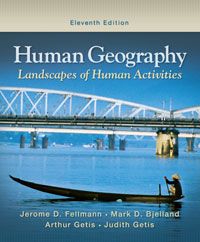1 A) burying wastes on land has led to contamination via leaks from the barrels. B) dumping wastes at sea has resulted in the contamination of the oceans. C) injecting the wastes into deep wells can trigger earthquakes. D) no satisfactory method of disposal has yet been devised. 2 A) agriculture B) hydrologic cycle C) industrialization D) urbanization 3 A) an increase in the amount of fresh water throughout the globe. B) an increase in volcanic activity. C) coastal wetlands would be submerged. D) the continental interiors of middle latitudes would receive greater precipitation. 4 A) depletion of agricultural soil through erosion. B) disposal of sanitary wastes. C) dumping of toxic wastes in approved dumpsites. D) increasing number of earthquakes occurring across the globe. 5 A) glaciers. B) thunderstorms. C) volcanoes. D) water vapor. 6 A) Africa. B) Asia. C) North America. D) South America. 7 A) agriculture B) hydroelectric power generation C) industry D) urbanization 8 A) increases in the incidence of skin cancer. B) increases in human vulnerability to a variety of infectious diseases. C) threats to the existence of the microscopic plankton at the base of the marine food chain. D) an increase in sea temperatures causing melting of the polar ice caps. 9 A) air. B) rocks. C) vegetation. D) water. 10 A) developed nations. B) developing nations. C) primate cities. D) urban areas. 11 A) decreasing. B) increasing. C) nonexistent. D) prohibited. 12 A) increases in atmospheric carbon dioxide. B) the nutrient enrichment of water. C) the conversion of sulfur dioxides into sulfuric acid in the atmosphere. D) the return of heated water to the environment. 13 A) allows soil to renew its fertility. B) decreases soil erosion. C) increases soil erosion. D) takes large amounts of land out of agricultural production. 14 A) increased automobile emissions from states like California. B) midwestern coal-burning power stations and industries. C) global warming. D) recent major volcanic eruptions in Asia. 15 A) less than 1 B) 10 C) 30 D) 56 16 A) a decline in fish populations in thousands of lakes and streams. B) reduced rates of forest growth. C) respiratory diseases and cancers in humans. D) the depletion of the earth's ozone layer. 17 A) 10 B) 30 C) 60 D) 75 18 A) detergent wastes. B) organic solvents. C) radio-pharmaceutical waste. D) spent nuclear power reactor fuel. 19 A) Every method for disposing of such waste has an impact on the environment. B) In North America, the average person produces six pounds of waste per day. C) Modern cultures differ from older ones only by the volume and character of their wastes. D) Much municipal waste is hazardous because it contains toxic chemicals. 20 A) New England. B) the Dakotas. C) the desert Southwest. D) the Lower Great Lakes. 21 A) from 1880 to 1980 the mean global temperature rose about 1° F. B) carbon dioxide in the atmosphere now totals 150% of its pre-Industrial Revolution levels. C) the seven warmest years between 1880 and 1991 occurred before 1945. D) global temperatures will continue to rise even if carbon dioxide amounts were stabilized at today's levels. 22 A) developing countries highly dependent on agriculture. B) industrialized countries with diversified economies. C) high-latitude areas such as Russia, Scandinavia, and Canada. D) tropical regions of the Earth. 23 A) their role in maintaining the oxygen and carbon balance of the earth. B) their ability to regulate surface and air temperatures, moisture content, and reflectivity. C) their contribution to the biological diversity of the planet. D) their ability to absorb the chemicals that contribute to depletion of the ozone layer. 24 A) global warming. B) soil erosion. C) desertification. D) tropical deforestation. 25 A) southwestern United States, Southeast Asia, and tropical Africa. B) North Africa, the Middle East, and central China. C) the Middle East, eastern Russia, the Arctic, and Australia D) North Africa, the Middle East, Australia, and the southwestern United States. 26 A) tropical wet climates. B) tropical dry climates. C) steppe and deserts climates. D) marine west coast climates. 27 A) CO2 deflecting heat away from the earth surface. B) the lack of CO2 . C) CO2 reflecting heat back towards the earth's surface. D) ozone attaching itself to the CO2 and replacing a portion of the earth's oxygen. 28 A) Europe. B) North America. C) South America. D) Asia. E) none of the above. 29 A) 48.8% B) 2% C) 0.65% D) 0.32% 30 A) is the same idea as the concept of "ceteris paribus" used by economists that allows one factor to change and then identify the subsequent results. B) identifies how the factor limits the ill effects of soil erosion, air/water pollution, or other environmental problem on the earth. C) is a manmade rule or gauge when passed sends governments into immediate action through their legislative processes to limit the effects of the factor and its subsequent problems. D) identifies the most deficient factor and determines whether or not the ecosystem can continue to develop under natural undisturbed conditions.





